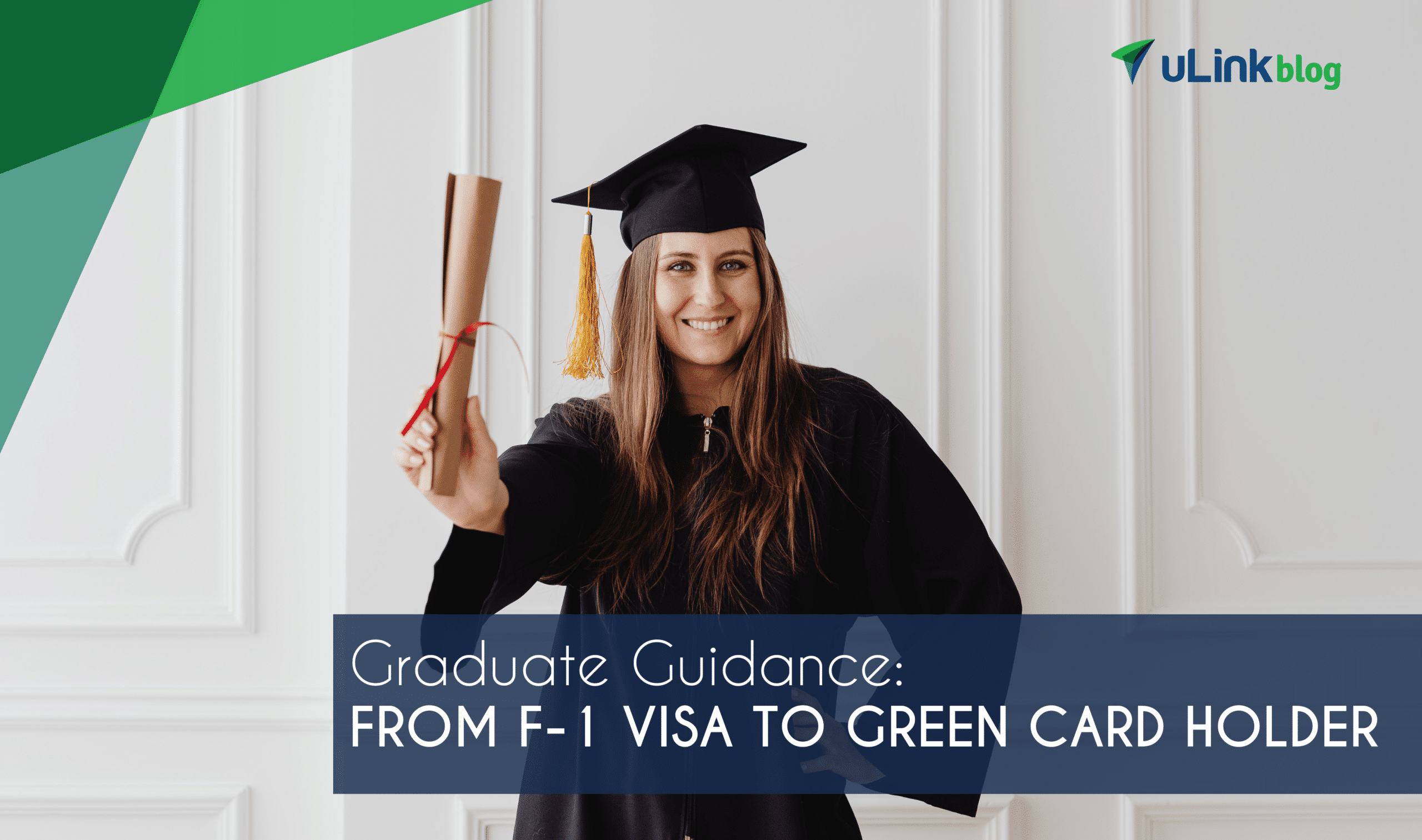
Congratulations! You’ve officially completed your college education, graduated, and entered the working world.
While it’s an undeniably exciting time, it can also be quite overwhelming.
Among the many questions you may be asking, one reigns supreme: how can you stay in America after your student visa expires?
After all, America is the place where you earned your degree, where you made valuable friendships, and where you developed your professional network.
Here’s the good news: there are several great ways to turn your F-1 Visa into a green card (or at the very least, to extend your stay by an extra year or more).
Read on to investigate the best options for your individual situation.
F-1 Visa vs. Green Cards: Differences and Benefits
An F-1 Visa and a Green Card share the same fundamental purpose: they both grant legal residency in the United States.
Upon closer inspection, however, an F-1 Visa is exclusively reserved for foreign nationals to study as full-time students in the U.S.
In order to receive an F-1 visa, you must declare your intention to study at an accredited institution, as well as your commitment to leaving the United States upon the conclusion of your education.
Therefore, while an F-1 visa limits your time in the U.S., a green card confers lifelong legal residency upon the holder.
According to the Department of U.S. Citizenship and Immigration Services, a green card “allows you to live and work permanently in the United States.”
Lawful permanent residents also gain a number of additional rights, including access to Social Security benefits, access to a driver’s license, and more.
Note: While a green card confers most of the rights enjoyed by citizens, it does not provide access to a passport or the right to vote in federal and local elections.
Getting a Green Card: 5 Paths to Permanent Residency
While the “green card lottery” is well known, these five paths to permanent residency are less of a gamble.
1. Self Petition as a Person of “Extraordinary Ability” (EB-1)
The EB-1 visa is difficult to obtain, but it’s worth considering.
To be deemed a “person of extraordinary ability,” you must provide evidence of
a major “one-time achievement” (like an Olympic Medal, a Grammy Award, or the Nobel Prize) to obtain a green card.
You will also be eligible for the EB-1 visa if you fulfill three or more of the requirements as defined by the U.S Citizenship and Immigration Services (USCIS).
Here’s the official list:
- Evidence of receipt of lesser nationally or internationally recognized prizes or awards for excellence.
- Evidence of your membership in associations in the field which demand outstanding achievement of their members.
- Evidence of published material about you in professional or major trade publications or other major media.
- Evidence that you have been asked to judge the work of others, either individually or on a panel.
- Evidence of your original scientific, scholarly, artistic, athletic, or business-related contributions of major significance to the field.
- Evidence of your authorship of scholarly articles in professional or major trade publications or other major media.
- Evidence that your work has been displayed at artistic exhibitions or showcases.
- Evidence of your performance of a leading or critical role in distinguished organizations.
- Evidence that you command a high salary or other significantly high remuneration in relation to others in the field.
- Evidence of your commercial successes in the performing arts.
To apply for an EB-1 visa through Form I-140, click here.
2. Receive Employer Sponsorship, Part 1 (EB-2)
If you don’t meet the criteria for an EB-1 visa, don’t worry: the EB-2 visa provides an equally compelling alternative.
This employment-based visa is available to graduates with an advanced degree “plus five years of progressive work experience in the field.”
You will be eligible for the EB-2 visa if you can provide the following documentation (as requested by the USCIS):
- An official academic record showing you have a U.S. advanced degree (or a foreign equivalent degree); or
- An official academic record showing you have a U.S. bachelor’s degree (or a foreign equivalent degree) and letters from current or former employers showing you have at least five years of progressive work experience in your field after you earned your bachelor’s degree.
Your employer will be required to complete the following instructions:
- Review the instructions for Form I-140, Immigrant Petition for Alien Workers.
- Complete and sign Form I-140.
- Pay the filing fee, if applicable.
- Provide all required evidence and supporting documentation.
Note: If you do not have a formal job offer, you can still qualify for an EB-2 visa. To do so, you must simply file a petition on your own behalf.
To obtain a “National Interest Waiver,” be sure to file a I-140 petition.
3. Receive Employer Sponsorship, Part 2 (EB-3)
Beyond the EB-2, employed-based immigration is possible for “skilled workers, professionals, and unskilled workers” (as defined by the USCIS).
The EB-3 takes a nuanced approach to assessing your unique education, skills, and work experience.
As a “skilled worker,” you must be able to:
- Demonstrate at least two years of job experience or training (not of a temporary or seasonal nature).
- Perform work for which qualified workers are not available in the United States.
- Provide a labor certification and proof of a full-time job offer.
As a “professional,” you will be eligible for the EB-3 visa if you can:
- Demonstrate that you earned a U.S. bachelor’s degree (or its foreign degree) related to your occupation and that this degree is the normal requirement for entry into this occupation. Note that education and experience cannot be substituted for a bachelor’s degree.
- Perform work for which qualified workers are not available in the United States.
- Provide a labor certification and proof of a full-time job offer.
As an “unskilled worker” – a moniker the USCIS uses to classify “other workers” – you must be able to:
- Perform unskilled labor (requiring less than two years of training or experience), that is not of a temporary or seasonal nature, for which qualified workers are not available in the United States.
- Provide a labor certification and proof of a full-time job offer.
If you satisfy these requirements, ask your employer to file for an EB-3 on your behalf. The filing process includes:
- Reading the instructions for Form I-140, Immigrant Petition for Alien Workers.
- Obtaining an approved Application for Permanent Labor Certification from the U.S. Department of Labor (DOL), if required for the specific visa category.
- Completing and signing Form I-140.
- Paying the filing fee, if applicable.
- Providing all required evidence and supporting documentation.
4. Marry a U.S. Citizen (K-1)
Thinking about the future with your college sweetheart?
If so, marriage would allow you to become a lawful permanent resident – as long as your significant other is a U.S. citizen.
In such a scenario, your partner would apply for a K-1 fiancé(e) visa, thus granting you residency in the United States for 90 days.
During this period of time, your marriage ceremony would take place, after which you can freely apply for permanent residency through Form I-129F, Petition for Alien Fiancé(e).
5. Consider CPT & OPT
If you aren’t yet eligible for a green card, don’t worry.
There are two short-term programs that may allow you to continue working in the United States for twelve more months.
These programs are known as Curricular Practical Training (CPT) and Optional Practical Training (OPT).
With CPT, students can obtain work through their educational institution (i.e., as a teaching assistant in an area related to their field of study).
Students can continue working for up to a year, at which point, the college or university may decide to sponsor the student.
With OPT, students can find a job from a U.S. employer and work for a full year.
Note: This employment opportunity must be directly related to the student’s major.
While OPT students are required to return to their home country after the 12 months expire, their employer will be in a position to sponsor them and directly petition the US Citizenship Immigration Services (USCIS).
To apply for OPT, the USCIS provides two key steps:
- Request that your designated school official (DSO) at your academic institution recommend the OPT. Your DSO will make the recommendation by endorsing your Form I-20, Certification of Eligibility for Nonimmigrant Student Status, and making the appropriate notation in the Student and Exchange Visitor Information System (SEVIS).
- Properly file Form I-765, Application for Employment Authorization with USCIS, accompanied by the required fee and the supporting documentation as described in the form instructions.
Bonus: Did you study science, technology, engineering, or mathematics (i.e., STEM)? If so, you may be eligible for a STEM OPT extension – which typically allows for 24 months of additional work.
Getting Started
Deciding to stay in the United States is no small decision, but with the right strategy (and a bit of patience), you can become a permanent resident and continue developing your post-collegiate career.
While you’re away from home, uLink is firmly in your corner to help you support your loved ones. With great exchange rates and fees starting as low as $0, you can send more money home than ever before.
Miles from home – just moments away with uLink.









